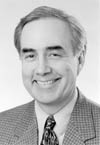Fall 1999
TV: Building Innovative Election Coverage for 2000
By Dave Iverson
Executive Editor
Wisconsin Public Television

Last October, teen mom Taranda Brown, an “A” high-school student, walked to a microphone in North Minneapolis and put the candidates for Governor of Minnesota on notice. Taranda was at Lucille’s Kitchen, a neighborhood restaurant. The candidates were in KTCA’s studio in St. Paul.
“Do you think neighborhood schools increase segregation and lower student achievement?” she asked. “And please answer true or false. I’ll give you a chance to elaborate later.”
Brown was one of hundreds of Minnesota citizens who participated in the gubernatorial debate, a project of KTCA and the Star Tribune.
Using compressed video technology, Minnesotans from locations as diverse as Lucille’s, with its African American patrons, to small towns in Northern Minnesota grilled the candidates on real issues.
Later, one woman commented from the small town of Crookston, “What really impressed me is that tonight Minnesota became a neighborhood rather than a state.”
Across the country, television stations are bringing new life to an old mission – covering local politics:
While we know that scores of stations are embracing the notion of innovative local election coverage, we don’t know a lot about how and why. For example, why did KTCA use compressed video? How well did it work; what did it cost? What are the pros and cons of commercial-public TV partnerships?
Why did Alabama Public Television decide to invest so many editorial resources in its web site; how many people did it take? What obstacles exist for stations who want to do more?
Finding out the answers is part of the purpose of Best Practices 2000, a new effort designed to encourage innovative coverage for the 2000 campaign. The project was initiated by Wisconsin Public Television and developed with the Pew Center for Civic Journalism and the Radio Television News Directors Foundation. In two different strategies, the project will:
1) Offer a series of workshops and resource materials, showcasing innovative techniques. They are open to all public and commercial stations.
2) Foster pilot projects in 10 broadcast markets. The project will partner public and commercial television stations and will provide small grants and resource support.
Pilot Collaborations
The partnerships could include:
Public stations could function as a kind of production house, doing anything from field production to studio recording of candidate statements or “free time” spots. The product would then be available to both stations.
Partners could share reporting and research to produce “ad watches” or other campaign coverage.
Previous public-commercial partners have simulcast political debates.
Some stations are considering a web partnership to feature election information and video streaming of the candidates.
In several cities, public stations have aired their commercial partner’s election coverage. It allows the commercial station just to do short updates on its air, and then when it returns to its entertainment programming, still get exposure on the public station.
Best Practices 2000 will provide support to the partnerships, as well as other interested stations, including:
Best Practices 2000 also plans to incorporate training in such digital advances as interactive TV and video streaming of candidates’ statements. As part of a model web site, the project plans a video-streaming demonstration project that would index candidate statements from several races. A site viewer would be able to search for what a candidate has said about an issue, both in the current race and in the past.
The project is in the process of identifying likely markets for the 10 pilot efforts. We’re also organizing the first workshop, scheduled for Dec. 10-12 in Washington, DC. It will focus on nuts-and-bolts ideas for covering elections and will showcase some of the most interesting work from 1998. The workshop is open to all interested stations.
______________________________________
Iverson recently received an Emmy Award for producing “The 30-Second Candidate,” a look at political advertising on television.
